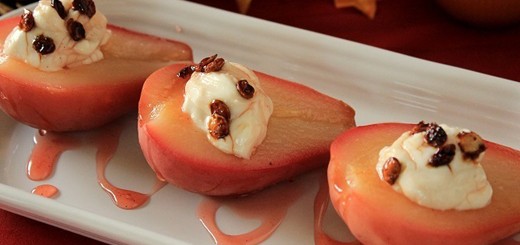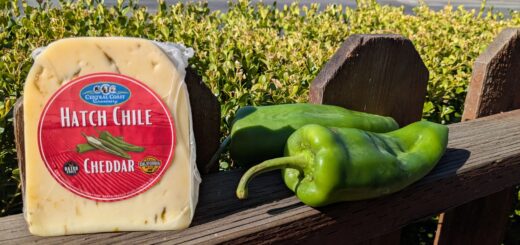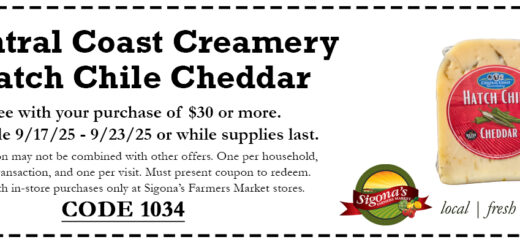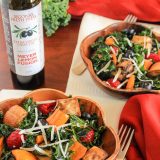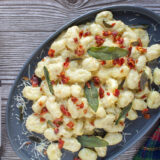In the Kitchen with Sigona’s for Passover and Easter
In the Kitchen with Sigona’s for Passover and Easter
When it comes to food, this time of year is one of the most meaningful and festive as the next week marks one of the most widely observed times of the religious year for Christian and Jewish families. Our Sigona family knows more about the Easter foods and traditions, but two things are common to both feasts: food and family.
Easter recipes from Sigona’s Family & Friends
Grandma Pauline’s Traditional Sicilian Stuffed Artichokes
Family recipe from John Sigona, Jr., co-owner
This artichoke recipe evokes vivid memories of my childhood when our extended family would visit my grandmother Pauline, my mom’s mom, and gather around the table set with a huge platter of these stuffed artichokes. Everyone would sit together and reach in to pluck off a leaf – it really brought the family together. Artichokes take a while longer to cook when prepared this way, but each petal bursts with layers of flavor so it’s worth it! Stuffs four large artichokes. – John Sigona, Jr.
Ingredients:
- 4 large artichokes (slice off the top 1 inch of the entire artichoke, use scissors to cut the tips off of each leaf and then slice off the stem/bottom so it sits up straight)
- 1-1/2 cups breadcrumbs
- 3/4 cup Sigona’s fresh press extra virgin olive oil
- 2 cloves garlic, minced
 1/2 of one onion, diced
1/2 of one onion, diced- 1.5 oz. anchovies, cut into pieces
- 1/2 c. grated Parmesan cheese
- Salt & pepper to taste
- 1 lemon
Directions: In a medium sauté pan, heat the olive oil over medium heat. Add garlic, onions and work for 1-2 minutes, being careful not to burn the garlic. Stir in the anchovies and melt into the oil. Cook for about 2 minutes.
Add in the breadcrumbs and reduce heat to low. Season with salt and pepper. Stir to bring the mix together. Turn off the burner and then stir in Parmesan. Set mixture aside.
Fit a large pot with a steamer basket and fill with about an inch of water and the juice of 1 lemon. Cover and bring the water to a low boil so it creates steam.
To stuff the artichokes, start at the crown and peel back a petal to make a little pocket. Fill the pocket with a small spoonful of the breadcrumb mix – remember you have 4 artichokes to stuff so measure spoonfuls accordingly. Move to the next petal; repeat until the entire artichoke is stuffed.
Set stuffed artichokes upright on steamer basket and steam until a leaf pulls out easily. Begin checking at about 35 minutes. When done, place on serving dish alongside an empty bowl to dump used leaves.
Gloria’s Mama’s Capirotada – A Mexican Bread Pudding
Family recipe from Gloria Gandolfo (part of the Sigona’s family for more than 25 years).
My mother has made this bread pudding at Easter for as long as I can remember, and it’s something our family looks forward to each year. To make it unique and festive, she dots the top with Easter-colored food coloring. This traditional Mexican dessert is flavorful, rich, sweet and comforting, and is best served warm. – Gloria Gandolfo
Ingredients:
- 6 cups day-old French bread (be sure it’s not sourdough), sliced and cubed
- 1/4 cup butter
- 1 1/4 cup water
- 3 cones of piloncillo (or 2 cups brown sugar)
- 1 cinnamon stick
- 1 tsp anise seeds
- 2/3 cup slivered almonds
- 1 cup raisins, soaked in warm water to soften
- 1/2 cup Monterey Jack cheese, shredded (or Queso Fresco, crumbled) Note: my mother usually sprinkles a bit more cheese on top when the pudding is done baking, so add an extra 1/4 cup of cheese if you plan do to the same.
- 1 TBL orange zest
- 1 tsp lemon zest
- 1/2 tsp ground cloves
- 1 tsp cinnamon
- 4 egg yolks
- 4 cups milk
- 1 pinch salt
- 1/4 cup sherry
Note: Some recipes call for apples. If using, peel, core and chop 2 large sweet apples, such as Fujis.
Directions: In a large bowl, combine almonds, raisins, zests and 1/2 cup cheese (and apples, if using). Stir in cloves and cinnamon. Set aside.
In a large sauté pan, melt butter over medium heat. Add in the bread and work until just golden. Then add in the fruit mixture and remove from heat.
Meanwhile, in a small saucepan, combine water, anise seeds, piloncillo (or brown sugar) and cinnamon stick. Boil gently until the liquid becomes syrupy, about 6 minutes.
Prepare a large baking dish by rubbing bottom and sides liberally with butter. Pour half of the bread mixture into the baking dish and top with half of the syrup mix. Repeat with the remaining bread and syrup.
Bake for 35 minutes 350 degrees.
While the pudding is baking, beat egg yolks in a medium bowl until foamy and smooth. Whisk in the milk, salt and sherry until smooth. Pour over partially cooked bread and bake for another 25-35 minutes or until top is golden. Sprinkle on more cheese if desired. Serve warm.
Grandpa John Sigona Sr.’s Easter Gnocchi
Family recipe from Carmelo Sigona, co-owner
I’ve got to say my father started me cooking at a very early age. I remember some of the first meals I cooked for the family were enjoyed and I got the kudos. Thus began my enthusiasm for experimenting with cooking.
I’ve been cooking potato gnocchi for some time, but only this Easter have I asked my father for his recipe.
Now, with my father at 87 years old, my conversation starts with him saying, “Carmelo you’ve got to feel the dough. Do you know what I mean?”
I smile and say, “Yes, dad, continue.”
We’ll I’ve decided to morph my dad’s scant directions with a few tips I’ve learned along the way to present to you a very simple, easy gnocchi recipe. – Carmelo Sigona
First, a few tips:
- Potato selection: I love Yukon gold potatoes for their consistency and sweetness but almost any kind of potatoes will do.
- Boiling potatoes: Boil them with skin on; this will keep the potatoes from absorbing too much water. Also don’t overcook: just until fork tender. You don’t want waterlogged and soggy potatoes.
- Peeling potatoes: Peel the potatoes warm and keep them warm when working them.
- Preparing potatoes: Use a potato ricer or strainer to keep the potatoes light and airy.
- Making the dough: When working the dough, add just enough flour to bind the mixture. Don’t overwork the dough. You want your gnocchi light.
- Cooking gnocchi: When cooking, have your water boiling gently. A high-rolling boil will destroy these tender morsels.
OK, now the recipe
Ingredients:
- 3 potatoes, boiled, drained, peeled and riced/strained as suggested above.
- 1 1/2 cups flour
- 2 eggs slightly beaten
- 1/4 cup Parmigiano Reggiano cheese
Directions: Combine ingredients in a bowl and gently mix with your hands (dust your hands with flour to help with mixing). Next, flour your counter top and hands and dump the combined ingredients onto the floured counter. Divide dough into small portions.
Roll out each portion with your hands until you have achieved the “snakes,” about ½ inch thick.
Once these are rolled out, cut into about 1/2 inch pieces.
You’ll notice some gnocchi have a ridged design – this is done by rolling the gnocchi over the backside of a fork prongs. You don’t have to roll the gnocchi over the backside of the fork to achieve the ridges; it’s not necessary, but it’s a nice touch if you wish. To do so, lightly roll over the backside of a fork on each gnocchi to imprint those little ridges.
In a large pot of gently boiling water, put small batches of gnocchi into the water for 30-45 seconds until it comes to the top (similar to how you know ravioli is cooked).
Drain and set aside.
Enjoying gnocchi
Now there’s a couple of ways to go from this point.
I like to have my sauce warm and ready to add the cooked gnocchi right in. I like to use a creamy Gorgonzola, using one of our may Gorgonzolas from Italy, or a butter and sage sauce, my two favorites. You can also use a basic marinara sauce. Just ready and place the gnocchi right into the sauce.
You can also place gnocchi into an ice bath to stop the cooking, drain and set aside for when you are ready to put into a sauce and serve.
Either way once you plate the gnocchi top with a little extra Parmigiano Reggiano and serve.
Paul Sigona’s Baby Artichoke Sauté
As luck would have it, Easter and the peak of local artichoke season is about the same time of year. I made this baby artichoke sauté for Easter once years ago and now it’s the dish everyone expects me to bring to the feast. It’s simple, but the garlic and olive oil add depth of flavor. – Paul Sigona, co-owner
What you do: Choose the smallest baby artichokes you can find. Trim them down until you reach the smooth, tender leaves. Cut in half and sauté in olive oil and minced garlic until browned and warmed through. They will have a firm and somewhat crispy texture.
The real secret here is not parboiling the small artichokes. The texture you’ll experience is similar to the grilled artichokes you’ll find in Sicily. It’s that easy. Serve warm or at room temperature.
Passover Recipes from Sigona’s Family & Friends
Special thanks go out to Sigona’s shoppers Helen Steinberg and Mrs. Ella Potash, from the Redwood City Jewish Center (www.jewishredwoodcity.com), for sharing these recipes.
Beet, Fennel & Jicama Slaw
Now that it’s getting warmer the beets and fennel are great. Doesn’t this salad sound fantastically fresh and delicious!
For the salad, gather even amounts of:
- Raw red beets
- Jicama
- Fennel
For the dressing, you’ll need:
- Fresh squeezed lemon juice
- Sigona’s Fresh Press EVOO
- Salt & pepper
Directions: Julienne even amounts of raw red beet, jicama and fennel. Place the beets in a bowl of cold water before mixing with the other vegetables so that they don’t color the other vegetables.
Make a dressing with 4 to 1 ratio of olive oil to lemon juice. Season with salt. Mix salad and serve chilled.
Traditional Charoset
A little history: Before the main course at a family Passover, the family — along with friends and others who join them — retell the story of liberation from slavery in Egypt and they use special foods help tell the story. One of these is Charoset, a mixture of fruit and nuts. It symbolizes the mortar the Hebrew slaves were forced to make to build in ancient Egypt.
When most American Jewish families sit down to their family Seder, the Charoset is a mixture of apples, nuts and wine, while other Jewish ethnicities favor different ingredients. For example, Sephardic Jews, those who come from Spanish, Arabic or Mediterranean lands, often use what’s popular in their own countries, such as dates or figs, pomegranates, pine nuts or even coconut.
Ingredients:
- 5 large Red Delicious apples, cored, peeled and finely chopped
- 1 cup walnuts, finely chopped
- 1/2 cup sweet wine
Directions: Combine the apples with the walnuts. Slowly add the wine. Mix to combine. Cover and refrigerate until ready to use.
Chicken Soup
Ingredients:
- One (1) 3 pound Rocky Jr. whole bird chicken, quartered
- 2 potatoes
- 2 onions
- 5 carrots
- 1 sweet potato
- Water to cover
- 2 tablespoons salt
Directions: Peel all vegetables. Slice carrots and chunk potatoes. Place chicken and vegetables in 6-quart pot. Add salt and water to cover. Bring to boil. Lower flame and simmer an additional 1 1/4 hours.
Passover Sponge Cake
Ingredients:
- 7 eggs, separated
- 1 whole egg
- 1 cup potato starch, sifted twice
- Juice of 1/2 lemon
- 1 1/2 cups sugar
Directions: Begin by separating the seven eggs and placing the whites in one bowl and the yolks in another. Add the 1 whole egg to the yolks and set aside.
Beat the egg whites until stiff, gradually adding sugar. Set aside.
Beat yolks in their bowl. Add lemon juice. Gently fold yolks into whites. Gradually fold potato starch into batter.
Pour into ungreased tube pan and bake at 350F for about 70 minutes. Remove from oven and invert cake to cool.
Modern Potato Pancakes (Latkes)
Who says you always have to peel potatoes! These potato pancakes are different because you don’t have to peel the potatoes; you just prepare them in the blender, so it’s easy too! Recipe courtesy of Helen Steinberg.
Ingredients:
- 2 cups raw baking potatoes, unpeeled (2 large potatoes)
- 2 eggs
- 1 small onion, diced
- 1/4 – 1 cup matzo meal
- Salt & pepper to taste
- Cooking oil for browning
Directions: Cut potatoes into the shape of French fries, placing the cuts in a bowl of water as you go. Drain and dry very well.
Put ingredients in the blender in the following order: diced onion, eggs, drained and dried potatoes, seasonings and then meal. Cover and turn on blender, stopping after all potatoes are ground up (about 1/2 minute). If mixture is too loose, add another cut of potato and add to the mixture. Drain off excess liquid.
Drop by tablespoonfuls into hot oil and brown on both sides. The latkes may be placed under the broiler for a few minutes to drain off excess oil. Serve with applesauce or sour cream.
Cook’s note: If preparing these any other time besides Passover, adjust recipe as follows: 1 TBL flour or matzo meal, plus a pinch of baking powder if desired.
Helen’s Green Apple Applesauce
There’s little to no sugar in this recipe, which makes it more figure friendly. Variation on Theme (similar to Beethoven’s Fifth Symphony): you may also add cooked plums, peaches, pears, cherries or apricots to apple mixture. Either cook separately or together. Recipe courtesy of Helen Steinberg.
Ingredients:
- 12 green apples, unpeeled*
- A pinch of sugar (or Stevia or organic agave syrup)
- A pinch of cinnamon, optional, to taste
- Water to cover apples
*Cook’s Note: If you do not have a Foley Mill, you’ll have to peel the apples and puree them in a blender.
Directions: Core and dice apples. Place in a big soup pot with sugar and cinnamon. Cover with water and bring to a boil. When soft, drain and process in a Foley Mill to an applesauce consistency.







